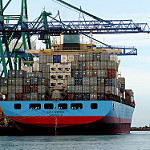In late August, a small container ship called the A Kinka left Hong Kong loaded with, among other things, 50-inch Roku TVs, aluminum cookware and Fender guitars, as well as about 26,000 backgammon and chess sets destined for a small toy company in California. It arrived off the coast of Los Angeles on Sept. 12, according to marine tracking data, steaming right into a traffic jam of dozens of ships. It floated in the Pacific Ocean for 54 days before it finally got a chance to unload its cargo, the <em>Wall Street Journal</em> reported. More than 100 companies needed cargo on the 574-foot-long ship, including giants like Amazon.com Inc. But for smaller businesses that were waiting for just one or two containers, the delays have taken a heavy toll, leaving some with disgruntled customers and significant financial pain. One small firm had Halloween boots that missed Halloween. Another couldn’t get paid for $250,000 worth of lighting fixtures it had sold until they were delivered. The A Kinka was one of dozens of ships backed up at the ports of Los Angeles and Long Beach this fall as companies scrambled to import goods ahead of the holiday season. It waited longer than most, but it was not alone. On Sept. 19, there were 100 container ships in the port, one of the most crowded days of the year. There were 73 ships waiting to unload while 27 ships were docked for unloading and loading, according to the Marine Exchange of Southern California. Some of the biggest container ships waited less than a week from when they entered the port until they reached a dock. Thirteen mostly smaller ships waited more than three weeks, with the A Kinka stuck for nearly eight weeks—the longest of those that didn't have mechanical issues. Larger companies have been better able to sidestep supply-chain delays because they have more resources at their disposal. Amazon had containers on more than half of the 100 ships backed up at port. The Ports of Los Angeles and Long Beach say they have handled a surge in imports this year and have taken recent steps to reduce the backlog, including switching to 24/7 operations.

